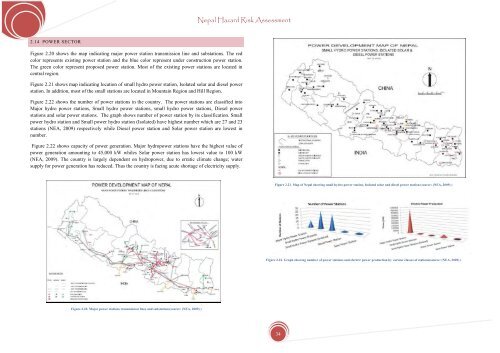Nepal Hazard Risk Assessment - Asia-Pacific Gateway for Disaster ...
Nepal Hazard Risk Assessment - Asia-Pacific Gateway for Disaster ...
Nepal Hazard Risk Assessment - Asia-Pacific Gateway for Disaster ...
Create successful ePaper yourself
Turn your PDF publications into a flip-book with our unique Google optimized e-Paper software.
<strong>Nepal</strong> <strong>Hazard</strong> <strong>Risk</strong> <strong>Assessment</strong><br />
2.14 POWER SECTOR<br />
Figure 2.20 shows the map indicating major power station transmission line and substations. The red<br />
color represents existing power station and the blue color represent under construction power station.<br />
The green color represent proposed power station. Most of the existing power stations are located in<br />
central region.<br />
Figure 2.21 shows map indicating location of small hydro power station, Isolated solar and diesel power<br />
station. In addition, most of the small stations are located in Mountain Region and Hill Region.<br />
Figure 2.22 shows the number of power stations in the country. The power stations are classified into<br />
Major hydro power stations, Small hydro power stations, small hydro power stations, Diesel power<br />
stations and solar power stations. The graph shows number of power station by its classification. Small<br />
power hydro station and Small power hydro station (Isolated) have highest number which are 27 and 23<br />
stations (NEA, 2009) respectively while Diesel power station and Solar power station are lowest in<br />
number.<br />
Figure 2.22 shows capacity of power generation. Major hydropower stations have the highest value of<br />
power generation amounting to 45,000 kW whiles Solar power station has lowest value to 100 kW<br />
(NEA, 2009). The country is largely dependent on hydropower, due to erratic climate change; water<br />
supply <strong>for</strong> power generation has reduced. Thus the country is facing acute shortage of electricity supply.<br />
Figure 2.21. Map of <strong>Nepal</strong> showing small hydro power station, Isolated solar and diesel power station (source: (NEA, 2009) )<br />
Figure 2.22. Graph showing number of power stations and electric power production by various classes of stations(source: (NEA, 2009) )<br />
Figure 2.20. Major power stations transmission lines and substations(source: (NEA, 2009) )<br />
34
















